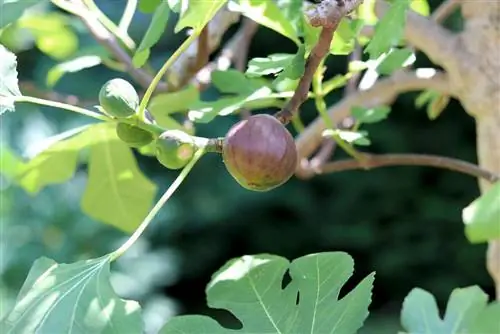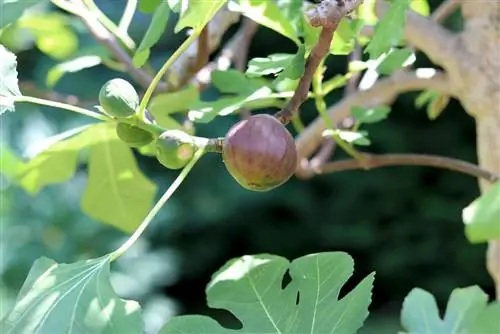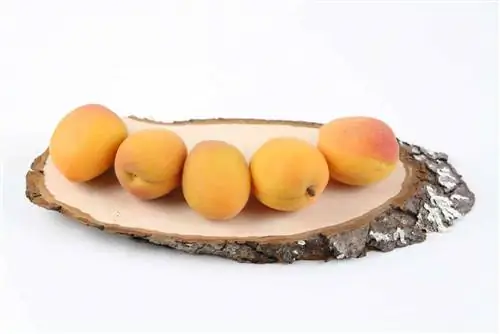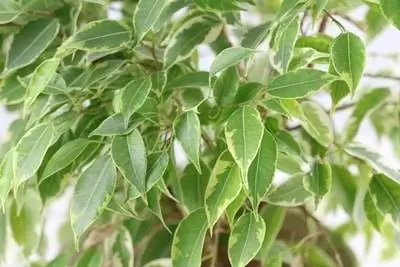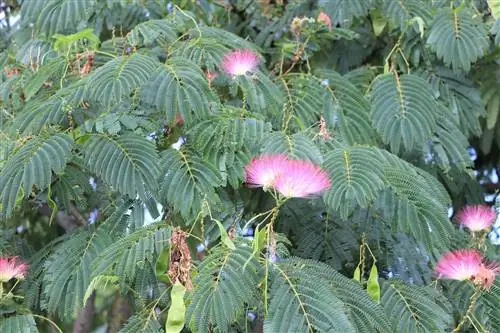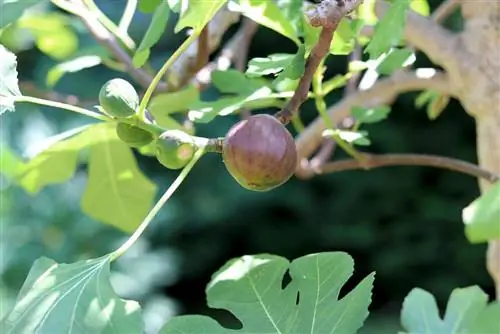- Author admin [email protected].
- Public 2023-12-17 03:39.
- Last modified 2025-01-24 12:45.
It gives the garden a rustic character and provides delicious fruit twice a year. To ensure that it stays that way for many years, the fig tree is pruned every year. This measure serves to restore its structure, prevents aging and generates new wood for a rich fruit covering. You can find out how to prune a fig tree professionally here. Practical instructions show the way and give tips at the perfect time.
The right time
Since the fig tree bears fruit twice a season, the date for pruning needs to be chosen carefully. The first figs grow on the two-year-old wood for a harvest in August, while the one-year-old wood invites you to pick the fruits again in October. This means that shape and maintenance pruning is not necessary during the summer in order not to deprive yourself of the second harvest. This requirement applies regardless of whether you cultivate the fig tree in a bed or in a container.
- always cut a ficus in early spring before the fresh shoots
- The months of March and April are ideal
- on the selected day there will be frost-free, overcast weather
Alternatively, choose a time during the winter on a frost-free day. In this case, however, you forego the advantage of the later date in the spring, when any possible frostbite will clearly become apparent.
Tip:
In a harsh winter, Mother Nature does the 'pruning'. If temperatures of -15 °C or colder prevail for a long period of time, a fig tree will freeze back into the frost-resistant wood all by itself. This can be recognized by the lack of green shoot tips.
Cutting instructions
A professional pruning of the fig tree is divided into two stages. In the first step, the rough cut ensures clear conditions, while the fine cut focuses primarily on the annual wood with the aim of encouraging further branching and the growth of fresh shoots. Here's how to do it:
Rough cut
- Cut off all main shoots close to the ground that hinder access to the tree.
- Select the six strongest main shoots that thrive at a sufficient distance from each other.
- Short this to the desired height by a third or half.
- Remove ground shoots that will shade or rub against each other when leafy.
- Cut one of two upward-facing competing branches.

Branches that are not cut close to the ground should be shortened to just above an outward-facing bud or a fork. New branches will sprout from this, which will bear fruit next year and the year after. After the rough cut, take a few steps back and look at the intermediate result. You should now be able to clearly see the desired structure of the fig tree. All dead wood is thinned out so that sun and air reach all areas of the tree. All supporting branches are at a sufficient distance from each other. Fruit wood that grows too densely does not achieve adequate strength to support the fruit. This circumstance significantly increases the risk of breakage. A distance of 10 cm should therefore not be significantly less than 10 cm. If you are satisfied with the result, the fine cut is on the agenda.
Fine cut
- Cut the still green shoot tips on the one-year-old wood by a maximum of half.
- Cut inward-facing branches completely.
- Cut off visibly stunted and diseased shoots.
- Cut away branches that cross or intertwine.
- Tear out water shoots in the root area.
If a main shoot had to be removed as part of the rough pruning, the strongest root shoot remains on the fig tree. A new key branch will develop from this within a short period of time. It is recommended to tear out the water shoots because not all parts can be completely removed by cutting. The faster an unwanted shoot shoots up again. Tip: During the summer, pinch out any shoots that sprout from the branches with your fingers. They should be removed at the latest when 5-6 leaves have formed because they consume unnecessary plant energy.
Rejuvenation cut
If you neglect to prune your fig tree for a few years, you will be confronted with an uneven, balding tree. However, clearing can be prevented because the ficus accepts a radical rejuvenation cut. In late winter, cut the entire bush down to a height of 30 cm. Leave the fig tree alone until next year. With a bit of luck, four to six branches will emerge that have what it takes to become the leading shoot. Cut these back by half. All other ground shoots have missed their chance and have to give way completely. In the following years, treat the saved fig tree to a professional pruning according to these instructions every spring.
Cutting the standard fig tree
Although a ficus is mainly cultivated as a shrub, hobby gardeners with limited space prefer the tree as a standard tree. Since the fig tree naturally has a stable structure and does not want to constantly sprout from the base, but instead branches intensively in the upper area, it is considered an ideal candidate for this elegant training variant. The younger the bush, the more docile it takes on the standard form. How to do it right:
- Determine a central, strong and straight growing branch as the main trunk.
- In the initial phase, support vertical growth with a wooden stake.
- Cut the remaining basic shoots close to the ground.
- Cut off all side branches along the trunk up to the desired crown height.
To form the crown, select 3 leading branches evenly spaced around the trunk. The angle is ideally 45 degrees. Cut the competing shoots to the leading branches back to Astring. Undesirable shoots from sleeping eyes from any stubs would torpedo the formation of the crown. It is important to note that the selected leading branches end at the same height, while the trunk towers over them. In this way you will create the desired juice balance.
Annual care cut
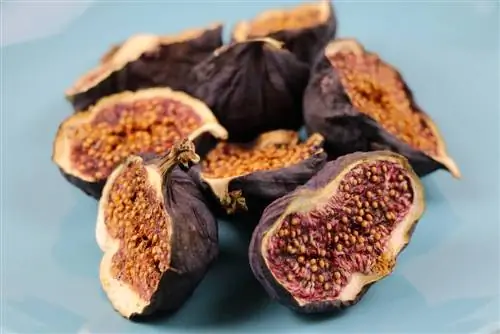
After successfully training a fig tree into a standard tree, the annual pruning differs only slightly compared to the bush. Again, the optimal time window for this care measure opens in March and April. More than 3 leading branches are not recommended; they should be shortened by a third. The extent to which you want further branching from the supporting branches is up to your individual decision. It is important to note that in the last step the trunk extension is trimmed so that it ends about 20 cm above the juice scale.
It is important to avoid that the fig tree's standard trunk develops an unclear center over the years. Which shoot occupies the position of the trunk extension should be clearly defined even after pruning. In addition, branch whorls have an unfavorable effect on growth and fruit production. If possible, the 3 leading branches should not branch at the same height from the trunk. An offset guide beam spread is cheaper.
Tip:
A weed-free tree slice effectively supports the vitality of the fig tree. When pruning and repeatedly during the vegetation phase, the prudent hobby gardener also pays attention to this aspect.
Conclusion
To ensure that a fig tree thrives he althily and vitally for many years, it benefits from annual pruning. Although the tree can be cut throughout the year, the optimal time is early spring in March and April. This date offers the advantage that the double harvest is not affected. In addition, during this time it is clear to see which parts of the plant suffered frostbite. If you cut your fig tree according to these instructions, you will ensure clear conditions in the tree, create the desired structure and generate new wood for repeated harvests.
What you should know about the fig tree in brief
Care
- In our Central European climate, figs are usually grown in pots.
- In some areas, however, you can try planting particularly resistant varieties.
- With winter protection, the figs can survive the winter, at least normal winters.
- Figs can be grown as bush trees or fan espaliers.
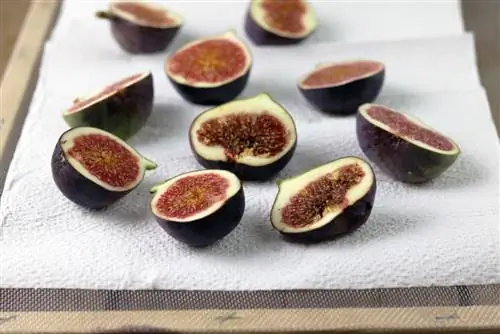
A trellis on a warm house wall in particular has advantages: the waste heat from the house ensures that the figs grow better and survive the winter well. The fig trellis is constructed like a normal fruit trellis. However, the shape usually doesn't seem so regular. There is more space between the arms.
Fig as a bush tree
- A fig tree usually does not need to be pruned.
- It's enough to light it occasionally!
- Cut out old fruit wood and diseased wood.
- If the tree has become too big, a fig tree can be cut without any problems.
- It can usually also tolerate a radical cut.
- Pruning is best done in early spring, i.e. in February or March.
- So that the harvest does not fail, do not cut away the two-year-old wood. This is where most fruits appear.
Fig trellis
The trellis is started at a height of 45 cm above the ground. The individual wires should be 25 cm apart. Ideally a two-year-old fig tree is planted in winter. You plant this about 20 cm away from the wall. In spring, the main shoot is cut - above the side shoot, which just towers over the lowest wire. Leave one shoot underneath. Both are then tied to two rods at an acute angle to the main shoot.
- Short both shoots above a strong bud to approx. 45 cm. Remove all other shoots!
- Next summer, select four strong shoots on each side shoot (one on each side), one at the end of the branch, one at the bottom, two at the top. Break out everyone else's eyes!
- Attach the eight branches to rods on the wire frame and direct them in the desired direction!
- Leave space between the new guide branches! Fig leaves can grow large and provide a lot of shade.
- Cut back leading branches in late winter of the following year! Cut above a bud that points in the desired direction of growth.
- Leave 60 cm of last year's wood! New shoots grow in summer. Break out unwanted eyes!
- It usually takes four years until the basic trellis is built. Then the fan only needs to be cut in spring and summer.
- Sick and damaged wood is removed in spring! The new growth is shortened one eye above the base.
- Tie up new shoots! Shoots growing towards or away from the wall!
- Remove old, bare branches one eye above the base.
- In summer, shorten new growth to five leaves.
Tip:
A trellis should not be too dense because all fruits need to receive equal heat and light.

